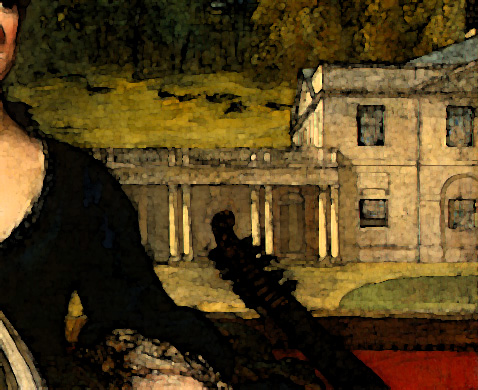
Fonthill Splendens. According to tradition, Beckford wrote Biographical Memoirs of Extraordinary Painters as a mock-guide to the art collections at Splendens.
Biographical Memoirs of Extraordinary Painters (1780)
Beckford's first published book - Biographical Memoirs of Extraordinary Painters (1780) - is a satire. In five biographical sketches of varying length, painters and artists as well as schools of painterly taste, are explored through means of fictitious and historical characters and places. Not one of Beckford's heavier works, the Memoirs is instead memorable for its lightness of touch and for the poetic descriptions of landscapes and paintings which it contains.Later on in life, Beckford amassed an impressive collection of paintings (today, some twenty of these may, for instance, be viewed at the National Gallery in London: works by Cima, Bellini, Botticelli, Raphael, Steenwyck, Dou, and Elsheimer - amongst others - stand out as spectacular examples not only of his taste but also of his considerable buying power). In the 1770's and very early 1780's, however, the time in which the Memoirs was composed and published, Beckford's home environment was defined by the art collections gathered by his father: the two Beckfords eventually came to share few, if any, artistic tastes.
Please use the links below to continue on to this online edition of the Memoirs. As this book has been scanned using OCR, errors have no doubt survived; the edition should be used as a rough study-aid only and the printed editions consulted whenever a quotation is needed.
"Advertisement.
THE editor of the following pieces is in possession of some particulars relative to the author, which, he has reason to think, might interest the curiosity of a respectable class of readers, and even prepossess them in favour of the publication. As, however, an impartial judgment on its merits is wished for, and the editor's availing himself of such an advantage might suggest the idea of attempting to bias the public opinion, no communication of the sort is allowed. Permission could not be obtained to mention even the particular age at which the author wrote these pieces. It was in vain the editor's partiality for them induced him to express something more than hope, that their merits with the public might rest little on that circumstance. For he has ever been persuaded, that the success of the most admired productions of the ingenium precox, at least in our own language, has been much more owing to their intrinsic worth than to the period of life at which [new page, not numbered] they were written. His principal motive, therefore, could he have imparted the particular last alluded to, had been only to contribute one fact more towards the science of human nature. The author's delicacy, however, was not to be overcome, and to that must be attributed the air of mystery, which, it is feared, may discover itself in introducing this publication to the world.
Whatever merit the plan of the following work may be thought to want in some respects, it is at least presumed to be new; and perhaps a better could not have been found for the display of a picturesque imagination. It was the design of the writer to exhibit striking objects both of nature and art, together with some sketches of human life and manners, through a more original medium than those usually adopted in the walk of novel-writing and romance. How far the attempt has succeeded is now left to the candid decision of the public.
THE EDITOR"
Aldrovandus Magnus ::: Andrew Guelph, and Og of Basan, Disciples of Aldrovandus Magnus ::: Sucrewasser of Vienna ::: Blunderbussiana ::: Watersouchy